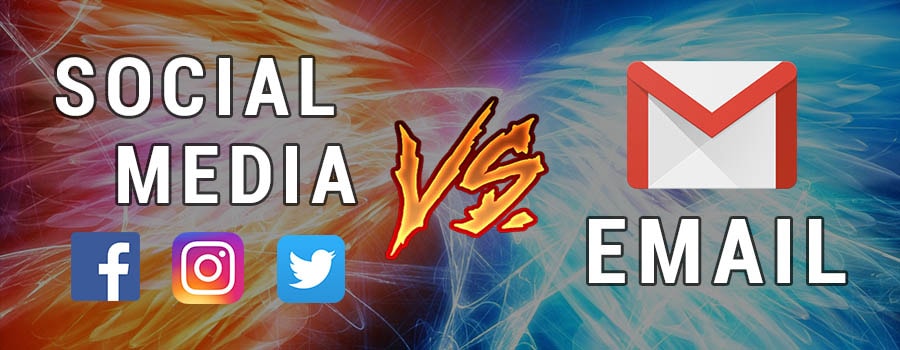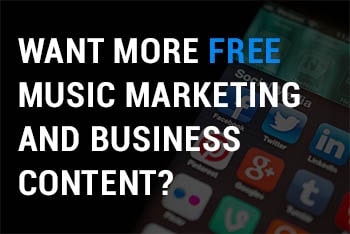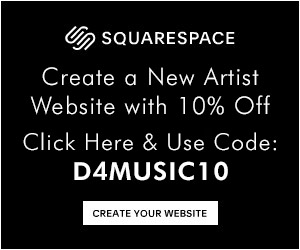
The two online marketing channels indie artists use the most often are social media and email. Both channels allow artists to interact with fans, but email actually plays a more direct role in helping artists earn money.
I’m sure you already know that an email is better for reaching fans directly as opposed to social media. The way I like to think about it, social media is where your fans likes to hang out during lunch breaks or after work. Email is like having their home address, or even cell phone number.
Regardless of where you are in your music career or what your goals are, your priority should always be to build your email list. Why?
One of your most valuable online assets is your audience or fan base. More specifically, your email list, because it’s the most direct way to reach fans on a large scale that you actually have control over.
For artists just starting out, your focus may be to build up social media followers, but ultimately you want them to become email subscribers.
Here are 4 stat comparisons that show why email is going to be key to your success as an independent artist:
1. Total Account Numbers
Email is a staple for communication in our online world. It has been around longer than most of the top social media platforms out there so you would expect it to have more accounts. Pointing this out is not the most convincing argument, but it does help put things into perspective. Hold on, because I’m going to throw numbers at you:
The current world population is 7.4 billion.
According to Radicati, the total number of worldwide email accounts is expected to increase to over 4.3 billion by the end of 2016. This means approximately 58% of the world population will have an email account.
According to Statista, the total number of social network users worldwide is 2.3 billion. The number of social media accounts consists of 32% of the world population, meaning that there are 2 billion more email accounts than social media accounts worldwide.
Based on these figures, it is pretty obvious that you can reach a lot more people via email than through social media accounts. You can also address an email and shoot it out to recipients across email platforms. This cannot be accomplished in social media. It will take a lot more time to send out your communication via each social media platform than one fully-loaded email.
2. Average Time Spent
The general perception is that people spend a good chunk of their online time in social media networks over email. However, a deeper dive into some research may prove otherwise.
Adobe surveyed more than 400 US-based white-collar workers, aged 18 and older, about their use of email. The workers questioned in the poll estimated they spend 6.3 hours a day checking emails, with 3.2 hours devoted to work emails and 3.1 hours to personal messages.
Glossing over the fact that these workers are using almost half their workday reading and responding to personal emails, there’s a lot of opportunities to reach your fans repeatedly throughout the day. It even provides the timeframe to remind them of your show later that night, so they can round up their work buddies and head over after work to see your set.
On the other hand, studies have shown that the daily time spent on social networks is around 1.72 hours a day.
If the email habits of white-collar workers that were studied can be attributed across the population, then the concept that social media takes up most people’s time during the day is false. Email never goes out of style.
3. Organic Reach
When trying to communicate something to your fan base, you want to make sure your fans actually get the message. The assumption is that all of our fans and followers see everything we post in their newsfeeds, which is becoming further from the truth, especially on Facebook.
Facebook Reach
Facebook gives you an initial organic reach of only 2%. Put another way, posting on Facebook with 1,000 page likes means only 20 fans will see initially see your post in the newsfeed. There is a chance that your post will be seen by more people if it receives engagement from your fans and followers.
As an advertising platform, Facebook wants to provide the best user experience to keep you in Facebook as long as possible. To do this, they use a complex algorithm to determine what are the best posts to show in your newsfeed that you will most likely engage with. If Facebook doesn’t think your post is good enough, your messages won’t effectively reach your fans.
Other Social Media Reach
The organic reach on Twitter is more than Facebook but still less than half of email. Twitter offers around 8% to 10% reach of your audience.
There isn’t available data that accurately reports the reach rate for other social media platforms, but earlier this year, Instagram announced that it was moving away from showing posts chronologically and following similar footsteps to Facebook by using an algorithm to determine what users see first.
It is safe to assume that Instagram’s reach will slowly decline, similarly to Facebook, to make sure artists put out only the best content for their fans. So unless you’ve been consistently engaging with your fans on this platform, your chances of reaching them on Instagram will slowly dwindle.
Email Reach
For the sake of this blog, we’ll consider when a person opens an email as reach. On average, your emails will reach 20% of your audience. With an email list of 1,000 fans, on average 200 of them will open your email. Through optimization and testing subject lines, you can definitely increase open rates for more reach. For tips on how to get more fans to open your emails, check out this blog.
Although there are no guarantees, certain techniques can help increase your open rate. It’s also important to know the likelihood that your fans are opening the emails you worked so hard to send.
The fact that music artists are at the mercy of social media channels makes a strong email list a much more attractive online asset. With an email list, you don’t need to worry about algorithm changes and hope that your posts will reach their intended audience in a market full of noise. Email reigns supreme as the most effective method of getting the attention of your fans.
4. Conversion Rates
I hope you’re listening (technically reading, but you know what I mean), because I am about to reveal the most important argument for why email is the most effective method to reach your fans. Drum roll please.
When it comes to getting fans to buy or spend money, email is the biggest influence. Take a look at these stats:
Conversion Rates by Channel
Email: 3.19%
Search: 1.95%
Social: 0.71%
In case you are not familiar with the term, conversion is when a fan completes a specific action you are directing them to take. For example, if you send an email to promote your new album, a conversion takes place when someone buys the album after reading your email. The conversion rate is simply the percentage of fans that took action based on the total number of fans that received the email.
Full disclosure, the numbers are dated a couple years. Even so, I don’t think any significant changes have occurred since then that would drastically change these numbers.
Similar findings have been noted in other studies. Another report stated that 66% of online consumers made a purchase as a result of an email marketing message. All this makes sense when you piece together all these stats to form the bigger picture.
As an artist who makes a living off your music, you need fans that will buy your music and pay to see your shows.
The numbers show that sending emails to your fans gives you the best chance of a recipient reading your message and taking action. It is the best way to reach your target market and sidestep the social media noise. Read emails will result in increased fan purchases of your music and merch, and is the most effective method in sustaining your music career long-term.
Conclusion
This is not to say that emails are the only thing that matters, and I’m not suggesting you ignore social media either. Social media is still important for engaging fans and deepening the fan relationship on a regular basis. The one big advantage of social media over email is its ability to go viral and have posts spread quickly.
Social media serves as a stepping stone to your email list. If your fan relationship looked like a funnel, social media represents the top larger end while email is part of the narrower end at the bottom. At the end of the day, both these marketing channels play an important role together in helping you grow and engage a loyal fan base.
Need help building an email list?
Click to learn the 5 most effective ways to build an email list.







